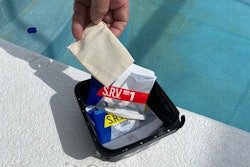In this month's edition of AQUA Architecture you'll find a terrific project profile by my good friends Sheri and Roger Soares, owners of HydroScapes, a custom design/build firm in Scottsdale, Ariz. Like just about all the stories we run in this section, there are some useful ideas that can be taken away and adapted to your own business.
In this case, the Soares' discussion could serve as a primer on solid design principles. "Design" is, of course, a vast topic and there are many ways to break it down. In considering the Soares' work on this project, we can neatly deconstruct the design process into three specific areas: the clients' ideas, preferences and budget; the setting, including the home's architecture, surrounding landscape and climate; and finally, the principles of competent design.
Superior results almost always occur when these three facets are fused by deliberate methods that unfold as the design process moves forward. In this case, the team dealt with sophisticated clients who had definite ideas about what they wanted. The designers listened carefully and sought clues they could use in developing the design specifics.
For example, Roger Soares noticed the wife had festooned her smart phone with a faux jewel case. This led to discussions that revealed she likes to have "a little bling" in her life, which in turn resulted in the designers presenting a number of glass tile options. At first the clients considered tile products on the lower end of the price scale, but upon seeing more beautiful and more expensive options, they increased what they were willing to pay. All of that resulted from one simple observation that could easily slide by less attentive eyes.
In another example, the clients wanted to include a masonry panel designed by Frank Lloyd Wright. The Soares team seized on that request to suggest that they create a metal gate treatment that echoed the design Wright used in the art piece.
The setting came into play in a big way as well. The home's contemporary architecture dictated a modular, mostly rectilinear design, which is reflected in the deck design and the rectangular pool, along with a number of other details. The arid climate dictated the use of succulents and cacti in the landscape.
In this case, the team wound up working with an architect who was designing a comprehensive remodel of the home. One thing led to another and the team helped oversee the entire remodeling process. That in turn meant they would be forced to address a number of drainage and grading issues, a huge amount of work that is now practically invisible.
Finally, all of the work was guided by sound design principles including scale, dimension, perspective, texture and color theory. As a major example, the color scheme used throughout the project was largely driven by copper colors that were used on the home's new roof. The result is a rich, yet subtle color scheme that works to soften the stark lines of the contemporary design, from the soft white stucco to the color of the rain gutters.
As we prepared this story, Roger shared a number of thoughts about how working in design is driven by his passion to learn everything he can about design theory and history. By studying design traditions of Europe and Asia, as well as master designers like Wright or Barcelona's Antoni Gaudí, he and Sheri have become conversant in the language of design. They understand that design doesn't necessarily mean creating dramatic works of artistic display, but that in so many situations, the result of good design is a feeling of harmony and balance that is intuitively pleasing, but not easily explained.
One of the most interesting things about this particular project is that all of the above took place on a relatively modest residential scale, which brings up my last point, and one that I have trumpeted more than once in the past.
The kind of design principles and methods discussed here are not the sole province of so-called "high-end" work. Yes, the budget will dictate the range of options available, but ultimately anytime you're placing a body of water in someone's home, the same elements of clients, setting and design knowledge can still come into play. Perhaps it's in the liner pattern selected for a package pool, or the size and placement of an inexpensive rectangular pool so that it maximizes the use of space and proportionally fits amongst its surroundings.
You don't have to work on projects suitable for the cover of Architectural Digest to benefit greatly from design education. Developing your design acumen will increase your confidence and expand your frames of reference as you discuss the possibilities with your clients, whether they have a six-figure budget or more limited resources. Ultimately, when you combine all of these main ingredients in a deliberate and sensitive way, superior results are almost assured.
Comments or thoughts on this article? Please e-mail [email protected].








































